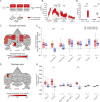Evidence for lateralization of fear emotions in the cerebellum
- PMID: 40447788
- PMCID: PMC12125079
- DOI: 10.1007/s00415-025-13183-0
Evidence for lateralization of fear emotions in the cerebellum
Conflict of interest statement
Declarations. Conflict of interest: The authors declare that the research was conducted in the absence of any commercial or financial relationships that could be construed as a potential conflict of interest. Ethical approval: Animal care and experimental procedures were performed in accordance with the European Communities Council Directive of 2010 (2010/63/EU) for care of laboratory animals and approved by a local ethics committee (Bezirksamt Arnsberg) and the animal care committee of North Rhine-Westphalia, Germany, based at the LANUV (Landesamt für Umweltschutz, Naturschutz und Verbraucherschutz, Nordrhein-Westfalen, D-45659 Recklinghausen, Germany). The study was supervised by the animal welfare commissioner of the Ruhr-University Bochum. Research involving human participants was approved by the local ethics committee.
Figures



Similar articles
-
Lateralization of observational fear learning at the cortical but not thalamic level in mice.Proc Natl Acad Sci U S A. 2012 Sep 18;109(38):15497-501. doi: 10.1073/pnas.1213903109. Epub 2012 Sep 4. Proc Natl Acad Sci U S A. 2012. PMID: 22949656 Free PMC article.
-
Cerebellum and Emotion Memory.Adv Exp Med Biol. 2022;1378:53-73. doi: 10.1007/978-3-030-99550-8_5. Adv Exp Med Biol. 2022. PMID: 35902465
-
The emotional cerebellum.Cerebellum. 2015 Oct;14(5):570-7. doi: 10.1007/s12311-015-0649-9. Cerebellum. 2015. PMID: 25626523 Review.
-
Chasing "fear memories" to the cerebellum.Proc Natl Acad Sci U S A. 2002 Jun 11;99(12):7814-5. doi: 10.1073/pnas.142288899. Proc Natl Acad Sci U S A. 2002. PMID: 12060724 Free PMC article. Review. No abstract available.
-
Differential Hemispheric Lateralization of Emotions and Related Display Behaviors: Emotion-Type Hypothesis.Brain Sci. 2021 Aug 3;11(8):1034. doi: 10.3390/brainsci11081034. Brain Sci. 2021. PMID: 34439653 Free PMC article.
References
-
- Adamaszek M, D’Agata F, Kirkby KC, Trenner MU, Sehm B, Steele CJ et al (2014) Impairment of emotional facial expression and prosody discrimination due to ischemic cerebellar lesions. Cerebellum 13:338–345. 10.1007/s12311-013-0537-0 - PubMed
-
- Batsikadze G, Diekmann N, Ernst TM, Klein M, Maderwald S, Deuschl C et al (2022) The cerebellum contributes to context-effects during fear extinction learning: a 7T fMRI study. Neuroimage 253:119080. 10.1016/j.neuroimage.2022.119080 - PubMed
Publication types
Grants and funding
LinkOut - more resources
Full Text Sources

